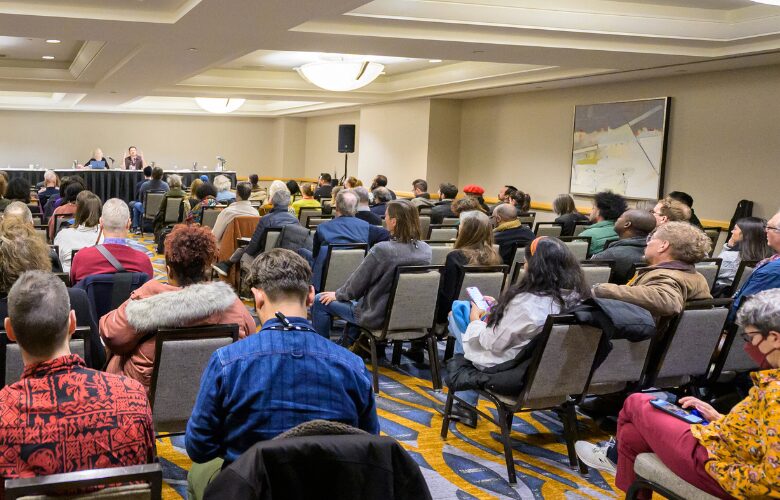Redefining Work in the Arts – APAP|NYC 2025

Redefining Work in the Arts: Retention, Wages, and Rest.
The performing arts industry has always relied on deep reserves of passion, grit, and adaptability. But in a post-pandemic world shaped by burnout, changing values, and new economic realities, arts leaders are rethinking how the sector treats its workforce. How do we retain talent, ensure fair compensation, and foster meaningful rest? That was the central theme of the APAP|NYC 2025 session, “Labor Issues: Retention, Wages, and Rest,” a candid conversation among field leaders navigating the shifting terrain of nonprofit work culture. APAP is pleased to share the content of this important conversation through the article below and the session’s video recording, continuing its mission to equip the arts community with the necessary tools to engage in meaningful advocacy for the arts.
Moderated by Jenny Bilfield, President and CEO of Washington Performing Arts, the session explored the duality many organizations face: post-pandemic pressures and constraints on one side, and opportunities to reimagine work on the other.
Alongside Bilfield were Heather Noonan, Vice President for Advocacy at the League of American Orchestras, and Courtenay Casey, Senior Director of Business Development at the Advisory Board for the Arts.
The panelists represented diverse leadership paths—from advocacy to data analysis to direct experience managing performance venues and organizations—and shared a united concern: if the performing arts sector is to thrive, it must take seriously the needs of its workers.
The pandemic cracked open long-standing tensions around labor in the arts, revealing the limits of overwork and the cost of attrition. As Heather Noonan shared, “Everyone’s job descriptions got rewritten overnight.” The urgency of digital pivots, staff shortages, and late-night funding applications created an unsustainable pace that left many exhausted.
But it also opened the door for new values to take root—especially flexibility, autonomy, and a focus on well-being. Courtenay Casey shared fresh data from a study of arts workers across the U.S., U.K., and Australia: the number one concern among staff is now job security, followed by management quality, flexibility, and only then—surprisingly—artistic reputation and diversity, equity, and inclusion. The data revealed thatworkers are seeking psychological safety, transparency, and more human-centered workplace cultures.
One of the most persistent challenges raised was managing across generations. Younger staff entering the field have different expectations around communication, transparency, and career growth—something not always understood or modeled by previous leadership generations.“Management quality”consistently ranked high in staff concerns, especially in organizations where formal training or mentorship in management is lacking.
Casey highlighted a need to upskill managers and build shared languages around values. Psychological safety and cross-departmental understanding were essential tools, she said, for moving teams beyond conflict and into collaboration. A standout example came from LA Phil’s production team, who created a shared etiquette guide to support communication between age-diverse crews.
While no one disputed that better pay is essential, all three panelists emphasized thatcompensation goes beyond salary.Benefits—retirement contributions, time off, coaching, sabbaticals—are increasingly important to staff, especially those in caregiving roles or planning for long-term stability.
Both Bilfield and Noonan recently took sabbaticals, offering a rare glimpse into how intentional rest at the leadership level can model sustainability for the whole team. In Noonan’s case, the League of American Orchestras formalized a 10-year sabbatical policy for all staff. Bilfield framed sabbaticals and coaching not as perks, but as retention strategies—critical tools for avoiding costly turnover and nurturing leadership potential.
Coaching, in particular, was highlighted as a powerful way to support emerging leaders, especially those stepping into complex roles. Bilfield shared how her team now offers outside coaching to mid-career staff as part of their professional development plans, emphasizing growth and resilience.
Retention doesn’t always mean keeping people forever—but it does mean investing in them while they’re with you. The panel offered several practical strategies for retention:
- Succession Planning: Not just for executives—every role needs cross-training and a long-term view.
- Growth Opportunities: Special projects, cross-departmental collaborations, and mentorships help activate the full spectrum of staff talents.
- Flexible Scheduling and Leave: Enforcing vacation use, creating “meeting-free” weeks post-sabbatical, and offering family care stipends show that rest is valued and protected.
- Candid Conversations: Bilfield and Casey both advocated for transparent discussions with staff about career goals—even if that means supporting transitions to other organizations.
The panel didn’t shy away from discussingemerging tools like AI and how they’re reshaping workflows. Used thoughtfully, they argued, AI tools can reduce administrative fatigue, synthesize complex data, and free up time for creative, relational work—without replacing the human element that’s core to the arts.
As one attendee asked how to make work more sustainable, Bilfield replied: “AI is just another tool. But it’s how we use our time—and how we care for each other—that will define the future of work in the arts.”
Ultimately, the conversation returned to a deeper truth:when workers feel cared for, they stay, grow, and contribute with passion. Whether it’s allowing children in the workplace, building cross-training systems, or simply asking, “What does success look like for you?”, the field must prioritize humane structures alongside artistic excellence.
“There was a time when the arts asked us to give up everything else—family, rest, boundaries,” Bilfield reflected. “That time has passed. Now, we build a field that makes room for whole people.”
Main image: Labor Issues: Retention, Wages, and Rest (Photo by Adam Kissick APAP)
Editor's Note: At StageLync, an international platform for the performing arts, we celebrate the diversity of our writers' backgrounds. We recognize and support their choice to use either American or British English in their articles, respecting their individual preferences and origins. This policy allows us to embrace a wide range of linguistic expressions, enriching our content and reflecting the global nature of our community.
🎧 Join us on the StageLync Podcast for inspiring stories from the world of performing arts! Tune in to hear from the creative minds who bring magic to life, both onstage and behind the scenes. 🎙️ 👉 Listen now!